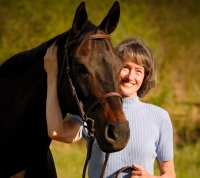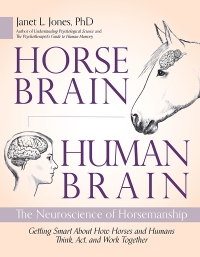TRUE TRAINING 90 - Soothing Anxiety or Rewarding Relaxation?
I try to train by non-edible reward as often as possible. It’s more effective, longer-lasting, motivates the horse to perform, and enjoys scientific backing. Relying mostly on non-edible rewards than on food treats allows me to vary the value of each reward according to the difficulty of the task performed.
The kinds of rewards I often use include stroking, scratching, speaking kindly, softening contact with the horse’s mouth, changing to an easier gait, riding with the horse’s natural motions, praising, dismounting, or putting the horse away in her comfy stall or pasture near her friends. Often, these rewards must be used during the ride itself. For instance, if I want to reward a horse for rounding into a softly raised back at a trot, I have to reward during the movement, not after it when the horse has stopped or changed behaviors. For that reason, my in-motion repertoire is limited in some ways. I certainly can't stop and pull food out of my pocket, or hold and press a clicker in one hand while jumping a green horse.
Like all horses, True is sometimes nervous or fearful, especially when noises occur in the indoor arena but outside of his view—the clanking of a bucket in the tack room, a rowdy conversation among friends just around the corner from the arena gate, a veterinarian administering shock therapy down the aisle, or a staff member stacking pallets against the outer arena wall with a tractor. These “ghost noises” worry True. But anything can scare a horse--sights, sounds, smells, or associations from previous experiences.
To combat anxiety, I continue riding usually at a walk or easy trot, waiting for a sign of relaxation. When True lowers his head or softens his neck, I stroke and praise him as we continue to move. Head-lowering and neck-softening are natural signs of equine relaxation, and I want to reward him for relaxing. When he adds blowing softly through his nose, I increase the value of his rewards by stroking with both hands simultaneously, reducing contact on the bit, and praising with the special use of his name. (I’ve trained True that his name is the highest form of verbal praise.)
This technique serves me well with many nervous or hot horses. It rewards a completely natural behavior, signifying to the horse that this easy behavior is exactly what I want: calmness, ease, relaxation. I often teach the technique to my riding students, as a way of teaching their horses to calm down as well. As the horse relaxes, we can move back up to faster gaits and more difficult tasks.
The trouble pops up when we mistake rewarding for soothing. Many people stroke and speak gently to a horse while she is nervous, as a way of soothing her discomfort. In effect, this practice rewards the horse for anxiety instead of relaxation, exactly the opposite of what we want. It’s a very easy mistake to make, partly due to the complexity of timing rewards and partly due to our natural instinct to soothe fear.
If you can separate the two, you’ll experience better results with your horse. She needs to learn that it is the relaxation you want, not the anxiety. While she is nervous, just continue riding. Don’t force her toward scary objects or become annoyed at her reluctance to approach. Never punish anxiety or fear, but don’t soothe it either because that soothing is going to feel like a reward to her.
Slow down if you need to, and ease up on challenging tasks, but continue moving. Nervous horses need to move because that’s what their prey brains are telling them to do. Standing still usually increases a nervous horse’s anxiety—standing like an immobile target is dangerous business for a prey animal and goes against all equine instincts.
So, continue moving but encourage natural relaxation to occur. Drop your hands slightly to encourage the horse to lower her head. Touch the reins gently in a random pitter-patter with your fingers. Bend her neck back and forth gently in moving serpentines or easy circles to soften it. As soon as she gives you either the head lowering or the neck-softening, that’s your moment! Praise and stroke, soften your contact, move fluidly with the horse. These are rewards your horse will enjoy and associate with the relaxation. Soon you will have a horse who wants to relax.

